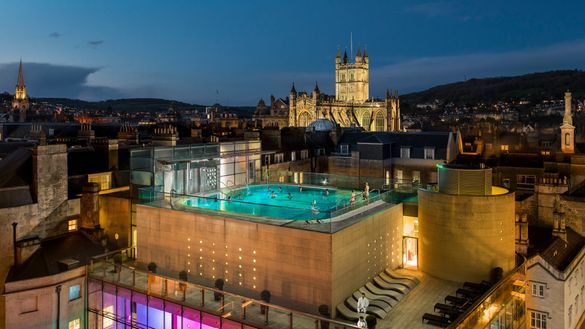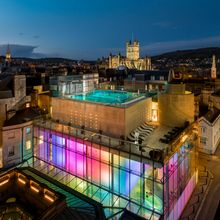 25 May 2022
25 May 2022
Regular visitors to Bath will know that the city gradually reveals its secrets, with each discovery revealing a previously unknown aspect of its story. From the Roman lead curse tablets thrown into the hot springs, the hoard of more than 17,500 silver coins discovered in the earth below the Gainsborough Bath Spa Hotel dating from between 32 BC and 274 AD, or the remains of the city's medieval church now visible from a glass window beneath your feet in Bath Abbey, the city's layers of history are fascinating.
And the natural thermal waters run through its veins, with the historic spa at its heart.
There is evidence to suggest that people worshipped the naturally warm mineral-rich waters well before the Romans built their settlement here. But since they built the first bathing structures in 60AD Bath has existed as a place to visit – for health, wealth and wellbeing.
While the Romans tended to segregate men and women for bathing, by the 18th-century bathing was mixed, but people were clothed. Women would wear lead weights in the hem of a shift dress to keep it from floating and allow them to remain 'decent'. They would also wear a hat and carry a floating tray containing refreshments and pomanders.
Having bathed they would be wrapped in towels and hurried back to their lodgings to 'recover'. The rest of their time was spent socialising, visiting friends, receiving guests, and attending balls and dances. You can find out more and take tea at the Pump Room, or visit the Fashion Museum at the Assembly Rooms, a building that was at the very heart of the 18th-century social scene.
There is a wide choice of guided tours of the city – by bus and on foot. A walk through the streets of Bath is a walk back in time. Follow in the footsteps of Queen Elizabeth I and Mary of Modena, wife to James II who came to Bath to 'take the waters'. They were followed by Queens Anne and Charlotte, both of whom visited the city in the 18th and 19th centuries.
With political turmoil in France and the ensuing reign of terror that followed the revolution of 1789, Bath became a fashionable place for the emigres seeking refuge and safety from the guillotine. There were regular reports in The Bath Chronicle of the day announcing the arrival of another count or countess lucky to have fled their homeland.
By the time that Jane Austen arrived in Bath and immortalised the city in two of her books (Persuasion and Northanger Abbey) the city's medieval walls had been breached to clear the way for expansion and new squares, crescents and terraces were thrown up as speculators cashed in on the property market. It is funny to think that when the author walked the streets, the city as we know it today would still have been relatively new.
It is worth looking out for the many plaques fixed to the walls of houses in the city centre which record the inhabitants from the past who made their mark. And William Lowndes book 'They Came To Bath' also records many of the rich and famous inhabitants who have contributed to the Bath 'scene' over the centuries. These include Benjamin Disraeli, who later became Prime Minister, astronomers William and Caroline Herschel, geologist William Smith, philanthropist Hannah Moore, abolitionist William Wilberforce, explorer David Livingstone, Admiral Sir Arthur Phillip, first governor of New South Wales, Australia, Admiral Lord Nelson, French Huguenot Sally Lunn, authors Charles Dickens, Mary Shelley and Sir Walter Scott, diarist Samuel Pepys, poets William Wordsworth and Percy Bysshe Shelley, artists Sir Thomas Gainsborough and Walter Sickert, composers Handel and Haydn, violinist Yehudi Menuhin, actors Sarah Siddons and Sir Laurence Olivier, the Vicomte Du Barré who died in a duel at Claverton Down, and the Princess de Lamballe, who came to England hoping to persuade the British to assist King Louis XVI and Queen Marie Antoinette escape at the height of the French Revolution, only to return to Paris to be executed during the September massacres of 1792.
Other famous people known to have lived or stayed in the city more recently include Haile Selassie I, Emperor of Ethiopia, who lived at Fairfield House, Newbridge during his exile from 1936 – 1941, actor Nicolas Cage, Tears for Fears duo Roland Orzabal and Curt Smith who grew up in the city in the 1970s and '80s, food writer, chef, baker and television presenter Mary Berry and celebrated film director Ken Loach.
Life hasn't always been about the rich and famous, seeing and being seen: Bath was and is a working city with servants and tradespeople. For an insight into what life was like 'below stairs' visit No1 Royal Crescent Museum, or discover the city's industrial and commercial heritage at the Museum of Bath at Work, housed in a former Real Tennis Court, built in 1777.
And after a day of sightseeing and discovering the wealth of history at your feet, why not rest your weary limbs and soak up a little more history in the naturally warm waters at Thermae Bath Spa. A 2-hour spa session costs from £38 and gives access to all the facilities.
After all, when in Bath… do as we've always done - bathe!



